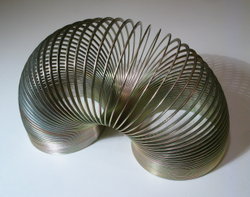Professor Andrej Cherkaev
(Андрей Всеволодович Черкаев)
Department of Mathematics
University of Utah,
email: cherk@math.utah.edu
URL: http://www.math.utah.edu/~cherk
Предварительные
задания по
курсу
Новые мат.
методы для
новых
материалов
New math for new materials
URL: www.math.utah.edu/~cherk/spb07
ИПМ
РАН, cПб,
Большой 61, В.О.
Ноябрь-Декабрь
2007.
С
вопросами
обращайтесь
по email: cherk@math.utah.edu.
Пожалуйста,
используйте
латиницу.
Prerequisites:
Before the class starts, the participants are kindly requested to work
on the topics,
listed below. This would allow for quick start of the short intensive
course.
The problems highlight the concerts that will be discussed. They are
not easy, and it is not expected that you will solve all of
them completely. However, it is expected that you
think about them and suggest ideas for the solution.
============= 1
=============
Dynamic
of unstable materials.
Dynamic
homogenization, waves of damage and phase transitions.
Phenomenon. Consider a train of standing domino pieces.
Assume that a wave of transition is initialized by a distant falling
piece that collides with the next piece and make it fall, and so on.
Falling domino pieces form a wave of transition.

Problems
a.
Formulate
the mathematical model(s) of falling dominos train. Suggest
simplifications of the model. Formulate the impact conditions. Derive
the
equations of the wave motion.
b.
Compute
(or estimate) the steady speed of this wave if size and mass of
a piece and the distance between then are known and assuming an
inelastic
collisions. Compare with experiment.
Advanced problems
c.
Formulate
a continuum description of the transitional wave.
d.
Assume
that the distances between domino pieces are not exactly the
same, but are randomly perturbed. Reformulate the problem; find the
average
speed of the wave and condition of its propagation.
e.
Assume
that the neighbor domino pieces are linked by a linear spring. Modify
the model.
f.
Suggest a two-dimensional extension of the
domino problem.
Related problem: Slinky - compute the speed of
walking slinky
=============== 2
===============
Optimal design of a structure
Consider an infinite strip made from a
laminate
of materials with the given conductivities k1 and k2. The difference of
potentials at the ends of the strip is equal to one. Determine the
proportion
of the materials in the laminate and the angle of its inclination to
the
boundary of the strip that maximizes the component of the current along
the strip.
Hint: the current across the field
gradient (along the strip) is due to anisotropy of the laminate. The
anisotropic conductivity depends on the orientation of laminates and
the fractions of materials within.
=============== 3 ===============
Structural
optimization and the finite-dimensional models.
Consider a square region filled with a conducting composite. The conductivity of isotropic components equals to k1 and k2, respectively.
Problem
Build a finite (NxN) square
lattice that models the conductivity of heterogeneous material (Figure
below). Enforce
the isotropy of components.


Assume that the unit density current propagates through
the upper and lower sides of
the square and two other sites are insulated (Left figure).
Next
Problems
1.
Find
an optimal
materials’ layout in the domain. The
aim is to maximize the conductivity of the domain. Assume that the
fractions of
materials are given. Is the solution unique?
2.
Formulate
a similar optimal layout problem for the lattice that mimics
the composite. Derive and analyze the optimality conditions.
============= 4 ==============
Search for new, hot, and exciting research topics
1. Familiarize yourself with popular and
demanded areas contemporary mechanics/applied math and learn the
searching
strategy. Find the most popular and demanded areas in contemporary
mechanics/applied math. Describe the recent advances in the chosen area
(you
may choose nanomaterials, biomaterials, smart materials, MEM, flexible
materials and folding, multiscale models, etc) based on listed below
websites.
Analyze the most discussed topics. Why are these topics popular?
· Find websites of major conferences: SES 2007, USNCCM9, IUTAM Congresses, SES Annual Technical Meetings, Euromech. Analyze the most discussed topics. Why are these topics popular?
·
Read
the table of contents of most important journals in the area:
Nature, Science News, JMPS, Applied mechanics, SIAM review, J of Solid
and
Structures, J of Structural and Multidisciplinary optimization, Theory
of
Elasticity, SIAM Journals.
·
Investigate
websites of major USA grant agencies: NSF (National Science
Foundation), Department of Energy (DOE), National Institute for Health
(NIH),
DARPA: AFOSR (Air Force Office of Scientific Research), and Office of
Naval
Research.
·
Look
through webpages of leading specialists in the field and faculty of
departments of Mechanics, Mechanical Engineering, Airspace Engineering,
and
Applied Math in the leading Universities.
2. Write a review about your findings.
Emphasize the areas of your personal interest. Focus on the needed
mathematical
technique. Emphasize the unknown terminology, methods, and topics.
Select the
most exciting and interesting applications.
3. Exchange information with your fellows and
start an informal junior seminar “Contemporary problems in mechanics”
discussing problems outside of the current area of expertise of your
group.
Выберете ваш(и) проект(ы) из списка
Source research:
Используя Интернет, подберите информацию об одном из следующих
"горячих" направлениях. Подготовьте доклад на 10-15 мин.
1. Optimal structures of composites
2. Optimal design
3. Phase transition and shape memory alloys
4. Smart materials
5. Nanostructures (nanotubes, nanocoils, C60, etc.)
6. Granular materials, flow.
7. Biostructures (bone mechanics, soft tissues)
8. Protein structures
9. Flexible materials: design and optimization
10. Wool, spaghetti, hairball: How to describe them?
Информация включает ответы на вопросы:
a. Почему люди изучают эту проблему? Почему именно сейчас?
b. Что решено и что еще нет? Сформулируйте нерешенные задачи.
and also:
c. Какие конференции по этой теме были и будут?
d. Где работают на проблемой (Университеты, Лаборатории, etc.)?
e. Проводятся ли летние школы по теме? Как туда подать заявку?
f. Какие организации финансируют исследования? Что эти организации
хотят?
g. Где публикуются результаты? Есть ли монографии по теме?
h. Имена. Контактные группы. Веб-сайты.